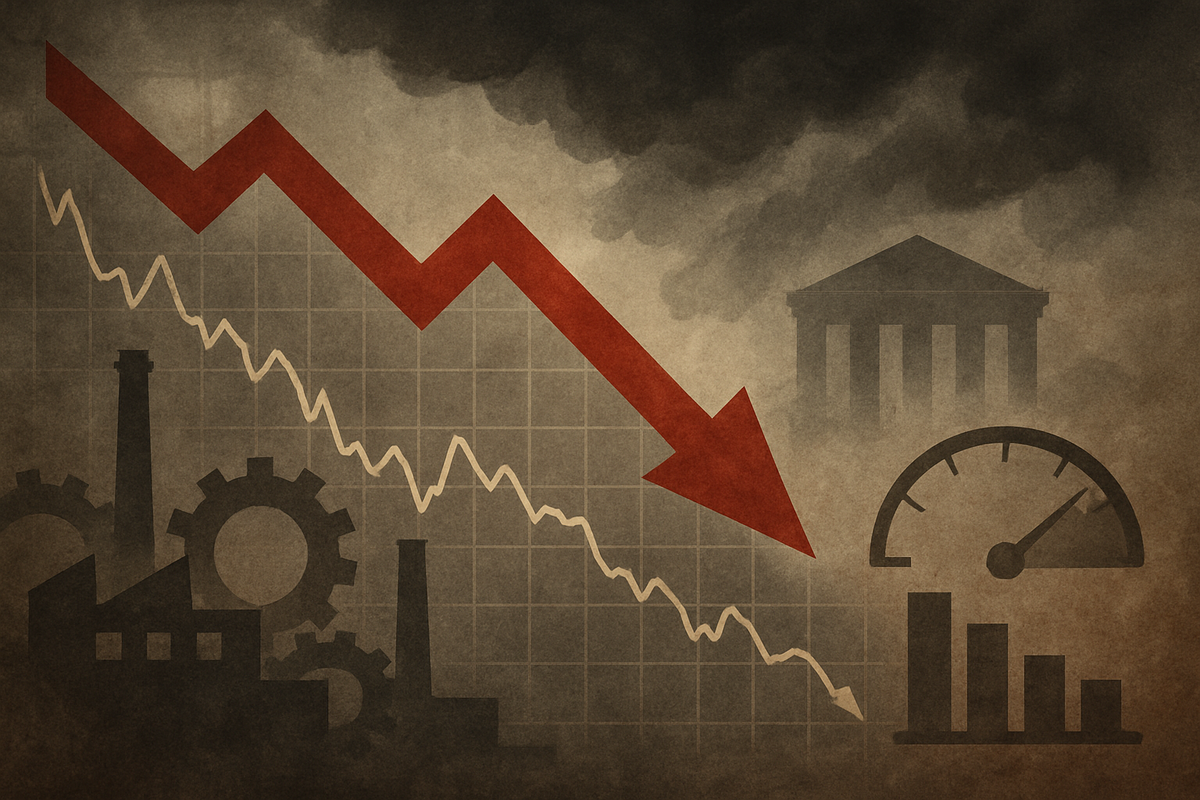
Financial markets are grappling with renewed economic uncertainty following a surprisingly weak manufacturing report from the Philadelphia Federal Reserve, which sent shockwaves through investor sentiment on October 16, 2025. The Philadelphia Fed Manufacturing Index for October plummeted to a deeply contractionary -12.8, starkly contrasting with September's positive reading and significantly missing analyst expectations. This sharp downturn has intensified concerns about the health of the US economy and fueled expectations for aggressive interest rate cuts by the Federal Reserve.
Compounding the anxiety, the highly anticipated September industrial production data from the Federal Reserve was delayed due to an ongoing federal government shutdown, leaving investors without a critical piece of the economic puzzle. The combination of a contracting manufacturing sector and missing data has pushed the yield on the US 10-year Treasury below 4%, signaling a flight to safety and pricing in almost certain 25-basis-point rate cuts at the upcoming October and December Federal Open Market Committee (FOMC) meetings.
Economic Indicators Signal Headwinds
The Philadelphia Fed Manufacturing Index, a closely watched barometer of regional manufacturing health, delivered a sobering message on October 16, 2025. The headline index plunged to -12.8, marking its lowest level since April and a dramatic reversal from September's robust 23.2. This figure not only indicates a contraction in manufacturing activity across the region but also fell far short of market expectations, which had anticipated a modest positive reading. A deeper dive into the sub-indicators reveals a mixed but concerning picture: while new orders surprisingly rose to 18.2 from 12.4, shipments fell significantly to 6.0 from 26.1, suggesting a slowdown in actual output. Employment also edged down, though it still indicates modest job gains. Worryingly, both prices paid and prices received increased, hinting at persistent inflationary pressures even amidst slowing demand. Despite the current weakness, the survey's future activity indexes offered a glimmer of hope, with expectations for growth over the next six months rising to 36.2.
This disappointing data comes as the market awaited the September US industrial production figures, which were scheduled for release on October 17, 2025. However, a federal government shutdown has indefinitely postponed this crucial report, leaving a void in the economic narrative. The last available data, for August 2025, showed industrial production ticking up a modest 0.1% month-over-month, slightly exceeding expectations, with manufacturing output also rising 0.2%. Capacity utilization stood at 77.4%. The delay of the September data means that market reactions on October 16 were singularly focused on the Philadelphia Fed's dire report, amplifying its impact.
The immediate market reaction was swift and decisive. The yield on the benchmark US 10-year Treasury note quickly reversed an earlier rebound, falling below the critical 4% threshold and edging towards a one-year low. This movement reflects a classic flight to safety, as investors de-risk from equities and move into less volatile government bonds, signaling heightened concerns about economic growth and potential recessionary pressures. Futures markets, in response to the data, are now pricing in near-certain 25-basis-point rate cuts by the Federal Reserve at both its upcoming October and December policy meetings, a significant shift in monetary policy expectations.
Corporate Fortunes in the Balance
The latest economic data has direct implications for various sectors and public companies, potentially creating winners and losers in the current market environment. Companies within the industrial and manufacturing sectors are likely to face immediate headwinds. For instance, large diversified industrials like General Electric (NYSE: GE), Honeywell International (NASDAQ: HON), and heavy equipment manufacturers such as Caterpillar (NYSE: CAT) could see demand for their products and services soften if the contraction signaled by the Philadelphia Fed Index becomes a broader trend. A slowdown in new orders and shipments directly impacts their revenue streams and profitability, potentially leading to revised earnings guidance and stock price volatility.
Conversely, companies that tend to perform well in a low-interest-rate environment or during economic slowdowns might find relative stability. The increased likelihood of Federal Reserve rate cuts could benefit real estate investment trusts (REITs) such as Prologis (NYSE: PLG) and Simon Property Group (NYSE: SPG), as lower borrowing costs and potentially higher demand for property could boost their valuations. Additionally, sectors traditionally considered defensive, such as consumer staples like Procter & Gamble (NYSE: PG) and Coca-Cola (NYSE: KO), and utilities like NextEra Energy (NYSE: NEE), may see increased investor interest as their stable earnings and dividends become more attractive amidst economic uncertainty.
Financial institutions, particularly banks like JPMorgan Chase (NYSE: JPM) and Bank of America (NYSE: BAC), face a more complex outlook. While lower interest rates can reduce their net interest margins, the prospect of an economic slowdown could also lead to an increase in loan defaults and tighter credit conditions. However, a significant shift in monetary policy by the Federal Reserve, aimed at stimulating growth, might eventually benefit these institutions by fostering a more robust lending environment, albeit after an initial period of adjustment and potentially reduced profitability from lending activities. The overall sentiment remains cautious, with investors closely watching how these companies adapt to the evolving economic landscape.
Broader Economic Implications and Historical Context
The sharp decline in the Philadelphia Fed Index, coupled with the delay in industrial production data, points to a potentially broader deceleration in US economic activity, fitting into a trend of increasing concern over a looming slowdown. This event intensifies the debate around whether the US economy is heading for a soft landing or a more significant downturn. The manufacturing sector, often seen as a bellwether for the wider economy, signaling weakness suggests that the cumulative effect of past interest rate hikes by the Federal Reserve might finally be taking a substantial toll on demand and investment. This could have ripple effects on global supply chains, affecting international trade partners and potentially leading to a synchronized global economic slowdown.
From a policy perspective, this data puts considerable pressure on the Federal Reserve. The market's aggressive pricing of rate cuts at the upcoming FOMC meetings indicates a strong belief that the Fed will need to pivot from its hawkish stance to a more accommodative one to avert a deeper recession. This scenario echoes historical periods where the Fed has had to rapidly adjust its monetary policy in response to deteriorating economic conditions, such as during the 2000 dot-com bust or the pre-Great Recession period. The challenge for the Fed will be to balance combating persistent inflation (as hinted by rising prices paid in the Philly Fed survey) with supporting economic growth, a delicate act known as achieving a "soft landing."
Furthermore, the federal government shutdown, which delayed the industrial production data, introduces an additional layer of uncertainty. Such shutdowns can erode business and consumer confidence, disrupt government services, and add to economic drag, making it harder for policymakers and businesses to accurately assess the economic landscape. This situation draws parallels to previous shutdowns, which, while often temporary, have historically contributed to minor economic disruptions and increased market volatility. The current confluence of a weakening manufacturing sector and political gridlock creates a challenging environment for economic forecasting and policy formulation.
The Road Ahead: Navigating Uncertainty
The immediate future for the financial markets appears poised for continued volatility as investors digest the implications of the latest economic data and the Federal Reserve's likely response. In the short term, market participants will be keenly focused on any further comments from Federal Reserve officials that might clarify their stance on interest rates, especially ahead of the upcoming FOMC meetings. The resolution of the federal government shutdown will also be critical, as the delayed industrial production data is essential for a comprehensive understanding of the economy's health. Until then, expect a cautious approach from investors, with a potential preference for defensive assets and a close watch on corporate earnings reports for signs of resilience or stress.
Looking further out, the trajectory of the US economy hinges significantly on the Federal Reserve's actions. Should the Fed indeed proceed with aggressive rate cuts, it could provide a much-needed stimulus to the economy, potentially mitigating the risk of a severe recession. However, the effectiveness of these cuts will depend on the underlying strength of consumer demand and business investment. Market opportunities may emerge in sectors that are highly sensitive to interest rates, such as housing and technology, should borrowing costs significantly decrease. Conversely, challenges will persist for companies heavily reliant on robust manufacturing activity or those burdened by high debt loads in a potentially slowing economy.
Potential scenarios range from a "soft landing," where the Fed successfully engineers a slowdown without triggering a recession, to a more pronounced downturn if economic weakness spreads beyond manufacturing. Investors should prepare for a period of heightened sensitivity to economic indicators, central bank communications, and geopolitical developments. The ultimate outcome will depend on a complex interplay of monetary policy, fiscal stability (including the resolution of the government shutdown), and the resilience of various economic sectors to prevailing headwinds.
Key Takeaways and Investor Outlook
The recent economic data releases paint a picture of increasing economic fragility, primarily highlighted by the sharp contraction in the Philadelphia Fed Manufacturing Index. This development, coupled with the delay in crucial industrial production figures, has significantly shifted market expectations towards more aggressive interest rate cuts by the Federal Reserve, underscoring concerns about a potential economic slowdown. The immediate impact has been a flight to safety, evidenced by falling Treasury yields, and a re-evaluation of risk across equity markets.
Moving forward, the market will remain highly sensitive to incoming economic data and, crucially, the Federal Reserve's monetary policy decisions. Investors should closely monitor not only the rescheduled industrial production report but also other leading indicators such as consumer confidence, retail sales, and inflation data. The actions and rhetoric of Federal Reserve officials will be paramount in shaping market sentiment and asset allocation strategies.
In this environment of heightened uncertainty, a diversified portfolio remains key. Investors should assess their exposure to economically sensitive sectors versus defensive plays. Companies with strong balance sheets, consistent cash flows, and resilient business models may offer better protection against potential downturns. As the market navigates these turbulent waters, vigilance and adaptability will be essential for identifying both risks and opportunities in the coming months.
This content is intended for informational purposes only and is not financial advice





